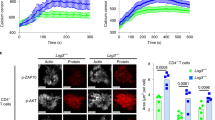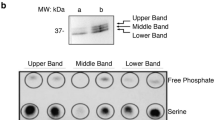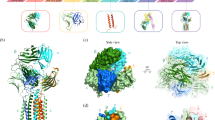Abstract
THE CD4 T-cell surface antigen is an integral membrane gly-coprotein of relative molecular mass 55,000 which binds class II major histocompatibility complex (MHC) molecules expressed on antigen presenting cells (APCs). It is thought to stabilize physical interactions between T cells and APCs (for a review, see ref. 1). Evidence is accumulating that suggests that CD4 can transduce an independent signal during T-cell activation2–4. It has recently been shown that CD4 expressed on human5,6 and murine6 T cells is physically associated with the Src-related tyrosine protein kinase p56lck (refs 7, 8). These results indicate that CD4 can function as a signal transducer and suggest that tyrosine phosphorylation events may be important in CD4-mediated signalling. Here, we present evidence that cross-linking of the CD4 receptor induces a rapid increase in the tyrosine-specific protein kinase activity of p56lck and is associated with the rapid phosphorylation of one of the subunits (ζ) of the T-cell receptor complex on tyrosine residues. These data provide direct evidence for a specific CD4 signal transduction pathway that is mediated through p56lck and suggest that some of the tyrosine phosphorylation events detected during antigen-mediated T-cell activation may result from signalling through this surface molecule.
This is a preview of subscription content, access via your institution
Access options
Subscribe to this journal
Receive 51 print issues and online access
$199.00 per year
only $3.90 per issue
Buy this article
- Purchase on SpringerLink
- Instant access to full article PDF
Prices may be subject to local taxes which are calculated during checkout
Similar content being viewed by others
References
Swain, S. Immunol. Rev. 74, 129–142 (1983).
Bank, I. & Chess, L. J. exp. Med. 162, 1294–1303 (1985).
Wassmer, P., Chan, C., Logdberg, L. & Shevach, E. J. Immun. 135, 2237–2242 (1985).
Rosoff, P. M., Burakoff, S. J. & Greenstein, J. L. Cell 49, 845–853 (1987).
Rudd, C. E., Trevillyan, J. M., Dasgupta, J. D., Wong, L. L. & Schlossman, S. F. Proc. natn. Acad. Sci. U.S.A. 85, 5190–5196 (1988).
Veillette, A., Bookman, M. A., Horak, E. M. & Bolen, J. B. Cell 55, 301–308 (1988).
Marth, J. D., Peet, R., Krebs, E. G. & Perlmutter, R. M. Cell 43, 393–404 (1985).
Veillette, A., Foss, F. M., Sausville, E. A., Bolen, J. B. & Rosen, N. Oncogene Res. 1, 357–374 (1987).
Veillette, A., Horak, I. D., Horak, E. M., Bookman, M. A. & Bolen, J. B. Molec. cell. Biol. 8, 4353–4361 (1988).
Sleckman, B. P. et al. J. Immun. 141, 49–54 (1988).
Patel, M. D., Samelson, L. E. & Kiausner, R. D. J. biol. Chem. 262, 5831–5838 (1987).
Bayinash, M., Garcia-Morales, P., Bonafacino, J. S., Samelson, L. E. & Kiausner, R. D. J. biol. Chem. (in the press).
Samelson, L. E. et al. J. Immun. 139, 2708–2714 (1987).
Veillette, A. & Bolen, J. B. in Oncogenes (Kleuver Academic, Norwell, Massachusetts, in the press).
Bookman, M. A., Swerdlow, R. & Matis, L. A. J. Immun. 139, 3166–3170 (1987).
Veillette, A., Horak, I. D. & Bolen, J. B. Oncogene Res. 2, 385–401 (1988).
Author information
Authors and Affiliations
Rights and permissions
About this article
Cite this article
Veillette, A., Bookman, M., Horak, E. et al. Signal transduction through the CD4 receptor involves the activation of the internal membrane tyrosine-protein kinase p56lck. Nature 338, 257–259 (1989). https://doi.org/10.1038/338257a0
Received:
Accepted:
Issue Date:
DOI: https://doi.org/10.1038/338257a0



